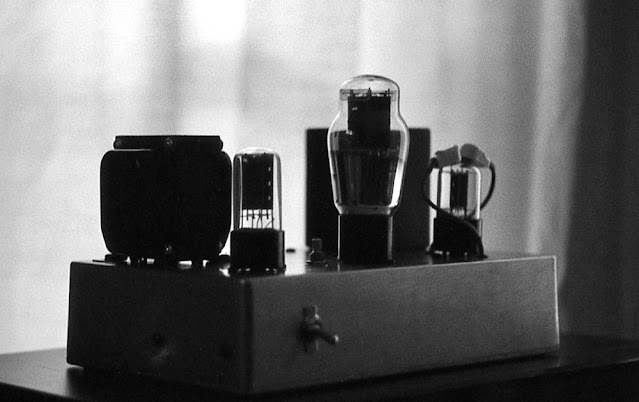Over two decades ago, I ventured into single channel music reproduction to trace the roots of high fidelity. From that whole experience, I developed an aesthetic quest for a certain purity and honesty in sound, which runs parallel with my other hobby of black and white film photography! Sadly, I had to leave that particular mono set up in the attic in 2017.
Building a hifi system is like a road trip - the journey can be just as much fun (if not more so) as arriving at the destination. When we returned to the states, I started with a mono SE2A3 integrated amplifier. As I started acquiring parts and components from radio shows, hamfests and flea markets, the set up progressed to its present state while retaining the essence of the mono hifi system I built two decades earlier.
Turntable + Tonearm(s)
In addition to the supplied Gray Research 108C viscous damped tonearm, the large top plate area of the Gray Research capstan drive turntable permitted the installation of the Velvet Touch 9" tonearm, which facilitates switching between mono cartridges in my collection.
Monaural Phono Cartridges
 |
| Left to Right: Denon DL102, GE VRII Pro, GE RPX Pro and GE single stud RPX with 78 stylus |
The Denon DL102 is fitted to the Velvet Touch tonearm, whose duties include tracing modern mono LP reissues as well as stereo LPs. I use a mild step up transformer before the phono stage just to warm things up a bit. A fresh nude conical tip was fitted by VAS Audio recently and it sounds as good as when I first unpacked it in the early 2000s.
All the GE cartridges are plug and play on the Gray Research 108C tonearm: my GE VRII Pro and RPX Pro are fitted with a 0.7 mil and 1 mil stylus, respectively, and are tasked to replay vintage mono LPs while the single stud RPX has a 3 mil stylus for 78 shellac playback.
Since these mono cartridges have been obsolete for over 60 years, I'm not getting in the midst of a genuine GE vs. generic replacement stylus debate. IME, whether original or generic, a bad sounding stylus is defective!
So what's the difference between the hard to find Pro and more common Non-Pro GEs? Basically, the pro versions have a lower source impedance for flatter frequency response at the expense of lower output. Subjectively, I find the older chrome bodied GE RPX Pro sounding more neutral in the midrange than the red bodied VRII Pro, albeit with less extension at the frequency extremes. This was also my reaction to their non-pro counterparts.
That said, the normal GE RPX and VRII are also great music makers and shouldn't be overlooked! Whether it's a pro or non-pro model, try loading them with 100k at the phono input instead of the 47k standard for a different sonic flavor.
FM Tuner
Digital Audio

!!!WARNING!!!
The voltages in this project are potentially lethal! Proceed at your own risk!
JE Labs Variable EQ monaural preamp
 |
| As the old adage goes, "If it ain't broke, don't fix it." |
My mono preamp has evolved slightly from the one I built a couple of decades ago.
The line stage is based on my plate choke loaded 76 circuit. I used a James JS4120N 200H @ 15mA nickel plate choke + a triode connected 6C6 tube as the voltage amp direct coupled to a 6SN7 dual triode with its two sections connected in parallel configured as a cathode follower.
Here's the 5Y3 rectified CLC power supply for the mono preamp.
SE2A3 mono amp
 |
| Click here for the schematic diagram + other details |
This mono amplifier using a Hashimoto H203S output transformer was originally featured in my Choke-Capacitance Coupled SE2A3 article.
Frank swinging with the SE2A3 mono amp + Altec mini 757!
SE46 mono amp
I built this amp because I lucked out on a UTC S14 output transformer.
 |
| UTC S14 specs |
While I was still in my PP EL84 and EL34 amp phase, I had one but didn't know any better. So I let go of it cheap at a hamfest. Soon after I acquired my two volume Isamu Asano tome, I regretted that decision because it was featured in a few of his lower powered SE amp projects. But as luck would have it, lightning struck twice! 😊
 |
| Click here for the power supply schematic |
Ever since audio circuit design and testing software became widely available, there's been a trend to revive the Julian Hirsch/Stereo Review era numbers game. Inasmuch as I love retro-hifi, that’s a period in audio history I’m not going back to. Fortunately the underground magazines, Stereophile by J. Gordon Holt and Harry Pearson's The Absolute Sound (TAS), were gaining traction by the time I got into the hobby.
TAS published an article about a GSI modification kit for the Dynaco ST70/MkIV amplifier in the mid 80s. I bought the CCS loaded cascoded 6DJ8s in dual differential mode circuit board kits. My Dynaco amps were transformed into miniature equivalents of Audio Research amps of that era! Eventually, I found the etched detail fatiguing and derived a lot more musical pleasure from my Eico HF87 with its EL34s strapped in triode. CCS loaded high-gm tubes are back in vogue!
My favorite era in audio was the 1930s, when huge resources were poured into developing sound reproduction. Directly heated triode output tubes ruled, driven by pre-miniaturization 6-pin pentode and 5-pin triode tubes. Although they had access to the best test equipment that generation had to offer, the sound of live unamplified musicians was the primary reference of sound engineers. The above choke-capacitance coupled schematic is based on what I learned from the pages of the third edition of the Radiotron Designers' Handbook from that epoch.
 |
| 100Hz, 1 kHz & 10 kHz square waves from the triode'd 6C6 CCC 46 + UTC S14 amp |
Despite the gloomy looking square waves at 100 Hz and 1 kHz, the UTC S14's midrange sounds cleaner than the budget Edcor GXSE15 and Hammond 125ESE I've tested in the past. Its overall performance reminds me of entry-level Japanese OPTs, like the discontinued Kasuga Wireless KA6625ST and the Sony/TamRadio RTR iron I used in my Simple 1626, Simple Triode 6F6/6V6 amps and line preamp project. Thus, I wouldn't recommend paying crazy money for this vintage UTC iron. It is definitely not for those whose concept of high fidelity is focused on subterranean frequencies.😉
Listening to my old mono LPs and 78s via the SE46 amp + GE A1-400 in a vintage DIY corner cabinet is time traveling!😊
SE10 mono amp
I recommend comparing the two topologies in the above schematic and choose what works best in the context of your hifi system and taste.
The power supply is a straightforward CLC using a 5U4 tube rectifier. To keep hum levels below audibility, I used a common mode choke filtered 7.5VDC filament supply for the type 10 triode. This was a circuit shared by my dearly departed friend Brian "mono fantastico" Clark, who was a type 801A triode + Lowther TP1 aficionado!
 |
| 100Hz, 1 kHz & 10 kHz square waves from the 6J5 + 156C + 10 + Tamura F7004 |
Here's a tune from Relaxin' with the Miles Davis Quintet!
The Altec mini 757 is a very modern sounding vintage speaker!😉
















Hello, for to order 6C6 in triode mode I just connect G2 to the anode and G3 to the cathode correct?
ReplyDeleteYes!
Delete